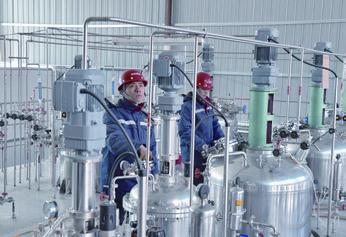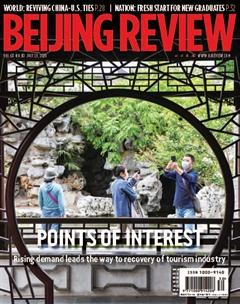Three for Thriving
By Wang Jun
With the Chinese economy moving toward high quality-oriented development from being manufacturing- and export-driven, the focus is on nurturing three“new economies”—new industries, new formats and new business models.
They are based on innovation with digitalization, big data, artificial intelligence (AI) and online retail spurring them on. Their growth has been remarkable, especially during the novel coronavirus epidemic, when many traditional sectors wilted.
In 2017, their growth value was 15.7 percent of the GDP. In 2019, it went up to 16.3 percent, or 16.19 trillion yuan ($2.32 trillion), the National Bureau of Statistics (NBS) announced on July 7. The growth rate calculated at current prices was 9.3 percent, 1.5 percentage points higher than the GDP growth in the same period.
Economic stabilizer
New industry refers to using new scientifi c and technological achievements and new technolo- gies to attain a certain scale of new economic activities. It includes the new industry directly generated by the industrialization of new technology application; by the traditional industry adopting modern information technology (IT); and by the promotion and application of scientif ic and technological achievements and IT.
New business format refers to the new links, chains and activities derived from the existing industries and fi elds by meeting diversifi ed and personalized product or service demands by harnessing technological innovation and application. It includes business activities based on the Internet; innovation of business process, service mode or product form; and more fl exible and fast personalized services.
New business model refers to the integration and reorganization of an enterprises internal and external elements of operation to achieve customer value and sustainable profi t and form an effi cient and competitive business operation mode. Specifically, it includes integrating the Internet with industrial innovation, integrating hardware into service, and providing one-stop consumption, entertainment and leisure services.
The added value of the primary industry of the three new economies in 2019 was 668.5 billion yuan ($95.64 billion), accounting for 0.7 percent of the GDP; the added values of their secondary and tertiary industries stood at 7.04 trillion yuan ($1.01 trillion) and 8.48 trillion yuan($1.21 trillion), equivalent to 7.1 percent and 8.6 percent of the GDP respectively, according to NBS fi gures.
“Development of the three new economies represents a very active achievement in supply-side structural reform,” Zhang Liqun, a researcher with the Department of Macroeconomic Research in the Development Research Center of the State Council, Chinas cabinet, told Peoples Daily.
According to him, the development of the trio in 2019 showed that the supply-side structural reform has been effective in an allround way. The rise of three new economies has not only stabilized economic growth, but also served as a new powerhouse for Chinas economic and social development.
“Fresh food e-commerce, big data, biopharmaceutical, AI as well as Internet-based marketing and online education are some of the new business formats and models that have demonstrated remarkable advantages since the outbreak of the novel coronavirus,” said Huang Zhengxue, head of the regional economy offi ce of the Institute of Spatial Planning and Regional Economy under the National Development and Reform Commission, in an interview with China Economic Times.
He said such new tools will become new drivers of economic growth, addressing diffi culties in social development, such as stabilizing and expanding employment.
Facilitating transformation
By fully making use of the Internet and IT, the trio has facilitated transformation of traditional industries, Zhang said. The advanced manufacturing industry is a good example of the combination of new technology and traditional manufacturing. Examples of the industry are special equip-ment for semiconductor devices, wearable smart devices and unmanned aerial vehicles.
“The three new economies benefi ted a lot from the macro-economic climate last year, leading to their rapid upsurge,” Zhang said. “This year, with the epidemic affecting the overall economy, especially the service sector, the three new economies are no exception but we can see that they are better able to resist risks.”
For instance, online offi ces have facilitated resumption of work and production, online education kept students learning during school disruption, and e-commerce experienced vibrant growth.
“They have become an important part of the Chinese economy and a new and vigorous force,” Zhang told Peoples Daily.“As they grow, they will better support rework and economic resumption in China.”
Long Haibo, Deputy Director of Innovation and Development Department at the Development Research Center of the State Council, said during the epidemic, in particular, many new business formats and business models have grown very rapidly, which has increasingly driven the growth of the new industries. However, the contributions of the three new economies to different industries vary a lot.
They have contributed the most to the tertiary industry, which mainly relies on the digital transformation of consumer services. Next comes their contribution to the manufacturing industry, with digital transformation bringing in great potential. In comparison, they contributed the least to agriculture, or the primary industry.
In the future, however, they are likely to help establish more emerging industries featuring multi-industry integration, Long told Securities Times.
He also said they can create more market demand and on the other hand, attract more people to work in the sectors generated by them since their values have increased substantially.
In recent years, some new categories of employees, such as live-streaming salespersons and delivery men, have been rated by some local governments as highprofile professionals, which affirms the social value of the three new economies.
In Zhangs view, the government should accelerate technology innovation, facilitate deep integration of digital and intelligent technologies with manufacturing and service industries, and advance digital transformation of traditional industrial chains in the light of local conditions. All these will boost the three new economies, injecting a steady stream of new drivers into economic and social development.
“In a market environment that is more relaxed, liberalized and tolerant in the future, the three new economies will make considerable progress, and their contribution to the GDP will also be increasingly higher,” he said.

